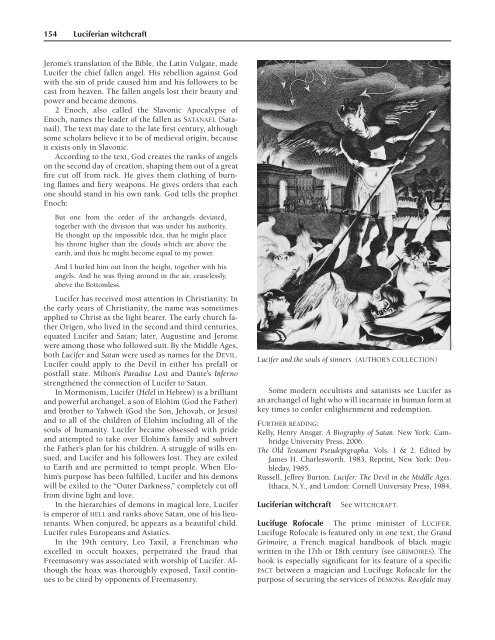The Encyclopedia Of Demons And Demonology
The Encyclopedia Of Demons And Demonology
The Encyclopedia Of Demons And Demonology
You also want an ePaper? Increase the reach of your titles
YUMPU automatically turns print PDFs into web optimized ePapers that Google loves.
154 Luciferian witchcraft<br />
Jerome’s translation of the Bible, the Latin Vulgate, made<br />
Lucifer the chief fallen angel. His rebellion against God<br />
with the sin of pride caused him and his followers to be<br />
cast from heaven. <strong>The</strong> fallen angels lost their beauty and<br />
power and became demons.<br />
2 Enoch, also called the Slavonic Apocalypse of<br />
Enoch, names the leader of the fallen as SATANAEL (Satanail).<br />
<strong>The</strong> text may date to the late first century, although<br />
some scholars believe it to be of medieval origin, because<br />
it exists only in Slavonic.<br />
According to the text, God creates the ranks of angels<br />
on the second day of creation, shaping them out of a great<br />
fire cut off from rock. He gives them clothing of burning<br />
flames and fiery weapons. He gives orders that each<br />
one should stand in his own rank. God tells the prophet<br />
Enoch:<br />
But one from the order of the archangels deviated,<br />
together with the division that was under his authority.<br />
He thought up the impossible idea, that he might place<br />
his throne higher than the clouds which are above the<br />
earth, and thus he might become equal to my power.<br />
<strong>And</strong> I hurled him out from the height, together with his<br />
angels. <strong>And</strong> he was flying around in the air, ceaselessly,<br />
above the Bottomless.<br />
Lucifer has received most attention in Christianity. In<br />
the early years of Christianity, the name was sometimes<br />
applied to Christ as the light bearer. <strong>The</strong> early church father<br />
Origen, who lived in the second and third centuries,<br />
equated Lucifer and Satan; later, Augustine and Jerome<br />
were among those who followed suit. By the Middle Ages,<br />
both Lucifer and Satan were used as names for the DEVIL.<br />
Lucifer could apply to the Devil in either his prefall or<br />
postfall state. Milton’s Paradise Lost and Dante’s Inferno<br />
strengthened the connection of Lucifer to Satan.<br />
In Mormonism, Lucifer (Helel in Hebrew) is a brilliant<br />
and powerful archangel, a son of Elohim (God the Father)<br />
and brother to Yahweh (God the Son, Jehovah, or Jesus)<br />
and to all of the children of Elohim including all of the<br />
souls of humanity. Lucifer became obsessed with pride<br />
and attempted to take over Elohim’s family and subvert<br />
the Father’s plan for his children. A struggle of wills ensued,<br />
and Lucifer and his followers lost. <strong>The</strong>y are exiled<br />
to Earth and are permitted to tempt people. When Elohim’s<br />
purpose has been fulfilled, Lucifer and his demons<br />
will be exiled to the “Outer Darkness,” completely cut off<br />
from divine light and love.<br />
In the hierarchies of demons in magical lore, Lucifer<br />
is emperor of HELL and ranks above Satan, one of his lieutenants.<br />
When conjured, he appears as a beautiful child.<br />
Lucifer rules Europeans and Asiatics.<br />
In the 19th century, Leo Taxil, a Frenchman who<br />
excelled in occult hoaxes, perpetrated the fraud that<br />
Freemasonry was associated with worship of Lucifer. Although<br />
the hoax was thoroughly exposed, Taxil continues<br />
to be cited by opponents of Freemasonry.<br />
Lucifer and the souls of sinners (AUTHOR’S COLLECTION)<br />
Some modern occultists and satanists see Lucifer as<br />
an archangel of light who will incarnate in human form at<br />
key times to confer enlightenment and redemption.<br />
FURTHER READING:<br />
Kelly, Henry Ansgar. A Biography of Satan. New York: Cambridge<br />
University Press, 2006.<br />
<strong>The</strong> Old Testament Pseudepigrapha. Vols. 1 & 2. Edited by<br />
James H. Charlesworth. 1983. Reprint, New York: Doubleday,<br />
1985.<br />
Russell, Jeffrey Burton. Lucifer: <strong>The</strong> Devil in the Middle Ages.<br />
Ithaca, N.Y., and London: Cornell University Press, 1984.<br />
Luciferian witchcraft<br />
See WITCHCRAFT.<br />
Lucifuge Rofocale <strong>The</strong> prime minister of LUCIFER.<br />
Lucifuge Rofocale is featured only in one text, the Grand<br />
Grimoire, a French magical handbook of black magic<br />
written in the 17th or 18th century (see GRIMOIRES). <strong>The</strong><br />
book is especially significant for its feature of a specific<br />
PACT between a magician and Lucifuge Rofocale for the<br />
purpose of securing the services of DEMONs. Rocofale may












